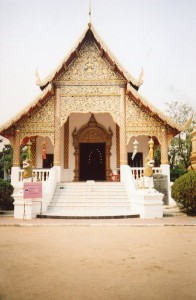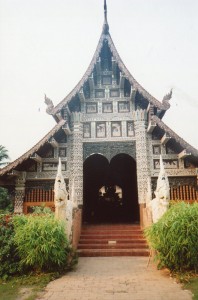The Thai vihara is one of the world’s greatest art forms. It’s also a key center of Thai experience.
The Thai vihara is the main assembly hall in a wat (Buddhist monastery) that lay people can enter. It marked a major cultural shift from the gargantuan temples that the former Khmer rulers built.
Thais liberated themselves from the Khmer overlords in the 13th century. At the same time, a conservative form of Buddhism from Sri Lanka was spreading through most of Mainland Southeast Asia. The Khmer pantheon had become bloated with every Hindu and Mahayana Buddhist deity that Indian imaginations could cook up. Kings built huge temples for them. These cults might have become remote from people’s daily lives.
But the faith that began to spread in the 13th century was the Theravada (old school). It stressed the Buddha’s original teachings–focus on daily life in a balanced and respectful way. This more down-to-earth religion was more human-scale.
Now one of the most sacred places in the temple was open to ordinary people. Rather than erecting huge piles of stone to honor a god, Thai Buddhists focused on the assembly hall.
Here, everyone could sit together, hear sermons, leave offerings, and admire paintings of the Buddha’s past lives on the walls.
The vihara was built from humble bricks, rather than pompous stones, and overlaid with soft stucco.
It’s a central place in the community, which people see as one of the main sources of goodness and order. They not only worship there, they also conduct fairs and thus mix fun with faith.
The atmosphere in every vihara I visited was gentle and tolerant. People always seemed comfortable with a Westerner plopping onto the floor with his overloaded shopping bags. They always let me witness their spiritual life for as long as I wanted to be with them. I miss the people, and plan to go back in a few months.



Comments on this entry are closed.